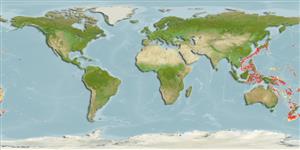Classification / Names
Common names from other countries
Main reference
Bộ gần gũi / Khối lượng (Trọng lượng) / Age
Max length : 14.0 cm TL con đực/không giới tính; (Ref. 559)
Môi trường
; Biển Tầng đáy biển sâu; Mức độ sâu 220 - 810 m (Ref. 41299)
Khí hậu / Phạm vi
Deep-water, preferred ?
Sự phân bố
Short description
This species is distinguished by the following characters: pelvic fin rays 11 (rarely 12); pectoral fin rays 13-15; projecting snout, 20-25% HL; no barbel; moderate orbit diameter, 30-33% HL; infraorbital width 13-15% HL; moderately long preopercular supporter, with obtuse angle at rear margin, 3-5% HL; 20-26 gill rakers; ventral striae reaching to ½ distance from pelvic fin bases to periproct; otolith has moderately high predorsal lobe, with colliculi separated, widely placed across collum, terminating at some distance from anterior and posterior rims of otolith; otolith length to height (OL:OH), 1.05-1.1; total colliculum length to pseudocolliculum length (TCL:PCL), 2.4-2.6 (Ref. 98298).
IUCN Red List Status (Ref. 115185)
Threat to humans
Harmless
Human uses
Thêm thông tin
Age/SizeSự sinh trưởngLength-weightLength-lengthLength-frequenciesSinh trắc họcHình thái họcẤu trùngSự biến động ấu trùngBổ xungSự phong phú
Các tài liệu tham khảoNuôi trồng thủy sảnTổng quan nuôi trồng thủy sảnCác giốngDi truyềnTần số alenDi sảnCác bệnhChế biếnMass conversion
Các công cụ
Special reports
Download XML
Các nguồn internet
Estimates of some properties based on models
Phylogenetic diversity index
PD50 = 0.5000 many relatives (e.g. carps) 0.5 - 2.0 few relatives (e.g. lungfishes)
Mức dinh dưỡng
3.2 ±0.40 se; Based on food items.
Thích nghi nhanh
Trung bình, thời gian nhân đôi của chủng quần tối thiểu là 1.4 - 4.4 năm (Assuming tmax>3)
Vulnerability
Low vulnerability (24 of 100)
Price category
